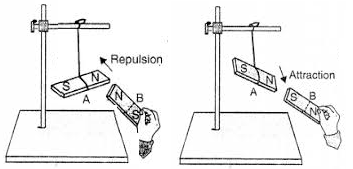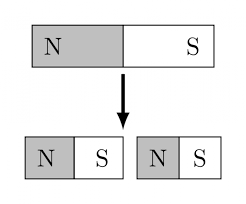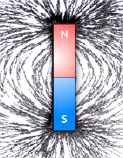Science > Physics > Magnetism > Properties of Magnet
In this article, we shall see the properties of magnet and experiments to verify them
Types of Material:
Magnetic Materials: Materials which are attracted by magnets are called magnetic material. e.g. Iron, cobalt, nickel
Nonmagnetic Materials: Materials which are not attracted by magnets are called non-magnetic material. e.g. glass, plastic, rubber.
Experimental Verification of Properties of Magnet
Experiment to Find Magnetic Material:
Bring a magnet near the material to be categorized. If the material is getting attracted towards the magnet, then the material is categorized as magnetic material. If the material is not getting attracted towards the magnet, then the material is categorized as nonmagnetic material.
Experiment to Locate Poles of a Magnet:
Suspend a bar magnet with twistless thread to a wooden stand such that it is capable of rotating about a transverse axis passing through its centre. Thus the magnet is horizontal. Let the magnet comes to rest. When it comes to rest, the end pointing towards the geographical north is called the north pole and the end pointing towards the geographical south is called the south pole.
Experiment to Show That the Strength of Magnet is Located at the Poles:
Take some iron filings in a dish. Place a bar magnet in it. We observe that the iron filings stick to the magnet but cluster around the poles rather than the middle portion of the magnet. This shows that the strength of the magnet is located at the poles.
Experiment to Show That the Like Poles Repel and Unlike Poles Attract:
Suspend a bar magnet with twistless thread to a wooden stand such that it is capable of rotating about a transverse axis passing through its centre. Thus the magnet is horizontal. Let the magnet comes to rest. When it comes to rest, the end pointing towards the geographical north is called the north pole and the end pointing towards the geographical south is called the south pole.

Now bring north pole of another magnet near the north pole of the suspended magnet. We observe that the north pole of the suspended magnet moves away from the north pole of the other magnet. This phenomenon is called the magnetic repulsion.
Now take away the other magnet and allow the suspended magnet to come to rest. Now bring south pole of another magnet near the north pole of the suspended magnet. We observe that the north pole of the suspended magnet moves towards the south pole of the other magnet. This phenomenon is called magnetic attraction.
Thus we can conclude that like poles repel and unlike poles attract. In this experiment, if you interchange the poles, the result will be the same.
Note:
If an iron rod is suspended in case of the magnet, then in both the cases the rod will get attracted towards the other magnet. Hence attraction is not a sure test of magnetism.
Experiment to Show That the Poles of Magnet Cannot Be Separated:
Take a thin bar magnet which can be cut by scissors. Mark its north pole and south pole. Cut this magnet into two halves at the centre. Put these pieces in iron filings. Iron filings get attracted to both pieces at the ends.

Suspend these pieces with twistless thread to a wooden stand such that it is capable of rotating about a transverse axis passing through its centre. Thus the magnet is horizontal. We observe that both the pieces come to rest in the north-south direction.
This shows that no matter how small you cut the magnet, each piece will have both the north pole and south pole. Thus the two poles of a magnet cannot be separated from each other.
A horizontally suspended magnet always comes to rest in the north south direction:
The earth itself is a giant magnet. Its magnetic North pole is near geographical South pole. Its magnetic South pole is near geographical North pole.
Now, unlike poles of magnet always attract each other and like poles of magnet always repel each other. Thus the north pole of the suspended magnet gets attracted towards the magnetic south pole of the earth (geographical north). Similarly, the south pole of the suspended magnet gets attracted towards the magnetic north pole of the earth (geographical south).
Thus the magnet when suspended in the air such that it is free to rotate about a transverse axis passing through its centre, it always comes to rest in the north-south direction.
If a bar magnet is suspended vertically, it does not hang in the north-south direction:
When a bar magnet is suspended vertically it is acted upon by two forces. Magnetic force due to earth’s magnetic field and the gravitational force due to earth’s gravitational field.
The magnetic force tries to align the magnet in the north-south direction, while gravitational force tries to move the magnet downward. The gravitational force acting on the magnet is much stronger than the magnetic force acting on the magnet. Hence, a bar magnet when suspended vertically, it does not hang in the north-south direction.
Repulsion rather than attraction is the test for identifying magnet:
Unlike poles of the magnet always attract each other and like poles of the magnet always repel each other. Thus there are two phenomena involved: attraction and repulsion. If there is neither attraction nor repulsion due to bringing a magnet near the material, then the material is nonmagnetic. If it is getting attracted then it may be magnetic or a magnet.
If the material is brought near a north pole of a magnet and is getting attracted. Then there are two possibilities Firstly, the material is magnetic and itself is not a magnet and is getting attracted towards the magnet and secondly, the material is a magnet and its south pole is getting attracted towards the north pole of the magnet.
Now, if a material is brought near a north pole of a magnet and is getting repelled. Then it means that the material is a magnet and its north pole is brought near the north pole of the magnet. Thus, repulsion rather than attraction is the test for identifying magnet.
These properties of magnet are used in different practical applications.
Next Topic: Magnetization, Demagnetization, and Induced Magnetization
